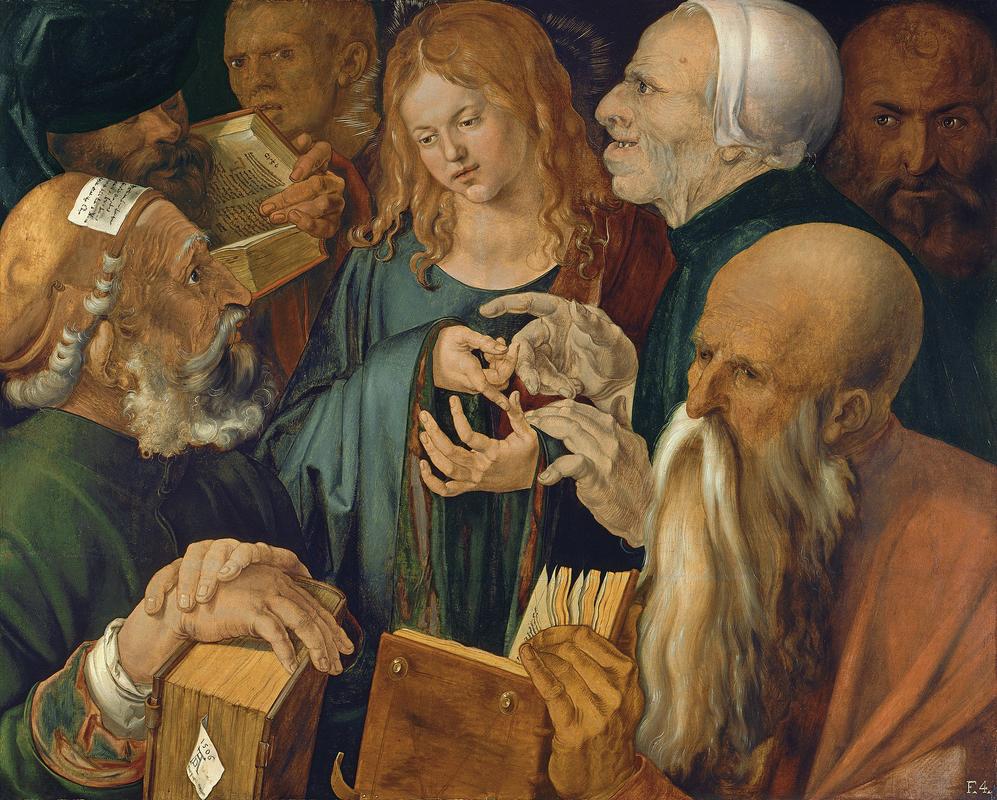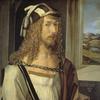More about Jesus Among the Doctors

Contributor
Albrecht Dürer’s blend of the Italian and Northern Renaissance painting tradition has been the juice of scholarly debate for decades.
Albrecht Dürer, the OG master of Northern Renaissance, was possibly most famous for his woodcuts and engravings, like Melanchonia I or the Knight, Death and the Devil, which he totally elevated to the next level. However, he was also a master of painting, especially after his visits to Italy, the birthplace of the Renaissance. Here, he learned all about one-point perspective and harmonious proportion, which the Italians were nuts about, and which became a staple in Dürer’s paintings. In fact, it was during his second stay in Venice that he painted Jesus Among the Doctors.
Even though there’s a huge debate about this painting among scholars, they can all agree on one thing: this painting is “unlike any other” work in Dürer’s oeuvre. I mean, duh, Dürer literally wrote that in a letter to a friend. The story depicted is of Christ as a twelve-year-old boy, leading a discussion with Jewish doctors in a temple in Jerusalem, while his parents think they’d lost him. In the Italian tradition, like in this painting, such a scene is depicted with Christ enumerating his arguments with his fingers. It is clear, then, that Dürer was influenced by the Italian art he witnessed in Venice.
What makes this picture quite rare, though, is the rapidity with which Dürer painted it. He claimed in another letter that he’d finished the work in just five days, and he made sure everyone knew it — in the painting, there’s a little piece of paper hanging out from the book on the bottom left that holds a Latin inscription that says opus quince dierum, meaning, ‘work of five days’. In order to paint that fast, though, Dürer used a different painting technique than he normally did; he stuck to only a few colors and applied the paint in large areas, without his usual meticulous mixing of hues.
Another thing that stands out in this painting is how full it is. There are heads on top of heads in what seems like a totally shallow space. The lack of background pushes the figures to the ‘front’ of the picture, making it a crowded, unbreathable composition. This is not only different from his previous renderings of this theme, whereby the composition is much more spread out, but it is also extremely non-Italian of him. It’s as if he forgot about the entire book on perspective that he’d written and just did it the old school way — the Gothic way. It’s not only the flatness of the picture that gives this painting a Gothic touch, but also the tangle of gesturing hands in the center that creates an almost ornamental pattern.
Perhaps the most intriguing feature of this painting, though, is the curious look of the faces. ‘Curious’ may be too diplomatic of a word, so let’s just say it: they are downright ugly. The old men’s ugliness spurred a debate on whether Dürer was directly inspired by the grotesque caricatures produced by Leonardo da Vinci. The resemblance is pretty obvious and Dürer most likely read Leonardo’s treatise on the topic.
But before we get ahead of ourselves, let’s consider the fact that Dürer was German and was heavily influenced by the Dutch and Flemish artistic tradition (especially Hieronymus Bosch, in this case). According to an old German tradition, the doctors are painted ugly because they are the enemies of Christ who, as the representation of good, is painted as a beautiful young boy. In other words, ugly = evil, beautiful = good. Creating this visual contrast between the protagonist and the antagonists makes the story easier to understand.
The fact that the "antagonists" are Jewish, however, sets off some alarm bells when looking at this painting from a contemporary perspective. Many have noted that the depiction of the doctors is pretty explicitly antisemitic. In fact, the National Gallery London recently removed a photo of this painting from promotions for a Dürer exhibition on their website after complaints about the offensive portrayal of Jews. Though the painting remained in the show, the museum conceded that the format of the website did not allow for the appropriate historical contextualization and acknowledgment of the antisemitism, which they promised to provide in the accompanying wall text and in the audio guided tour.
Sources
- Bialostocki, Jan. “‘Opus Quinque Dierum’: Dürer’s ‘Christ among the Doctors’ and Its Sources.” in Journal of the Warburg and Courtauld Institutes 22, no. 1/2 (1959): 17–34. https://doi.org/10.2307/750557.
- Deuchler, Florens. “ALBRECHT DÜRER.” The Print Collector’s Newsletter 2, no. 1 (1971): 4–5. http://www.jstor.org/stable/44130079.
- Hall, James, and Kenneth Clark. Dictionary of Subjects and Symbols in Art. London: John Murray, 1984.
- Panofsky, Erwin. The Life and Art of Albrecht Dürer. Princeton, NJ: Princeton University Press, 1955.
- Salisbury, Josh. “National Gallery Removes 'Antisemitic' Portrait from Website Ahead of Exhibition.” Jewish News, October 26, 2021. https://www.jewishnews.co.uk/national-gallery-removes-antisemitic-portr….
- Wisse, Jacob. “Albrecht Dürer (1471–1528).” In Heilbrunn Timeline of Art History. New York: The Metropolitan Museum of Art, 2000–. http://www.metmuseum.org/toah/hd/durr/hd_durr.htm (October 2002).
Featured Content
Here is what Wikipedia says about Christ Among the Doctors (Dürer)
Christ among the Doctors is an oil painting by Albrecht Dürer, dating to 1506, now in the Museo Thyssen-Bornemisza, Madrid, Spain. The work dates to Dürer's sojourn in Venice, and was executed (according to the inscription Opus Quinque Dierum, meaning "Made in five days") hastily while he was working at the Feast of the Rosary altarpiece.
According to some sources, it could have been given to painter Giovanni Bellini. In the latter's house it was perhaps seen by Lorenzo Lotto, who used one of the figures in the painting for his Madonna with Child between Sts. Flavian and Onuphrius now in the Borghese Gallery. The subject had been already treated by Dürer in a woodcut of the Life of the Virgin series and in a panel of the Seven Sorrows Polyptych. However, in the Venetian work the German artist adopted a totally new composition, with the characters occupying the whole scene and surrounding the young Jesus, leaving a little room for the black background.
The topic is the Finding in the Temple episode from Jesus' childhood, found in the Gospel of Luke. The character at the left of Jesus is a true caricature, perhaps inspired by one of Leonardo da Vinci's drawings seen by Dürer. The man in the lower left corner has a cartouche on his beret, a custom of the Pharisees. The one on the opposite side is perhaps a citation of Bellini.
Check out the full Wikipedia article about Christ Among the Doctors (Dürer)














